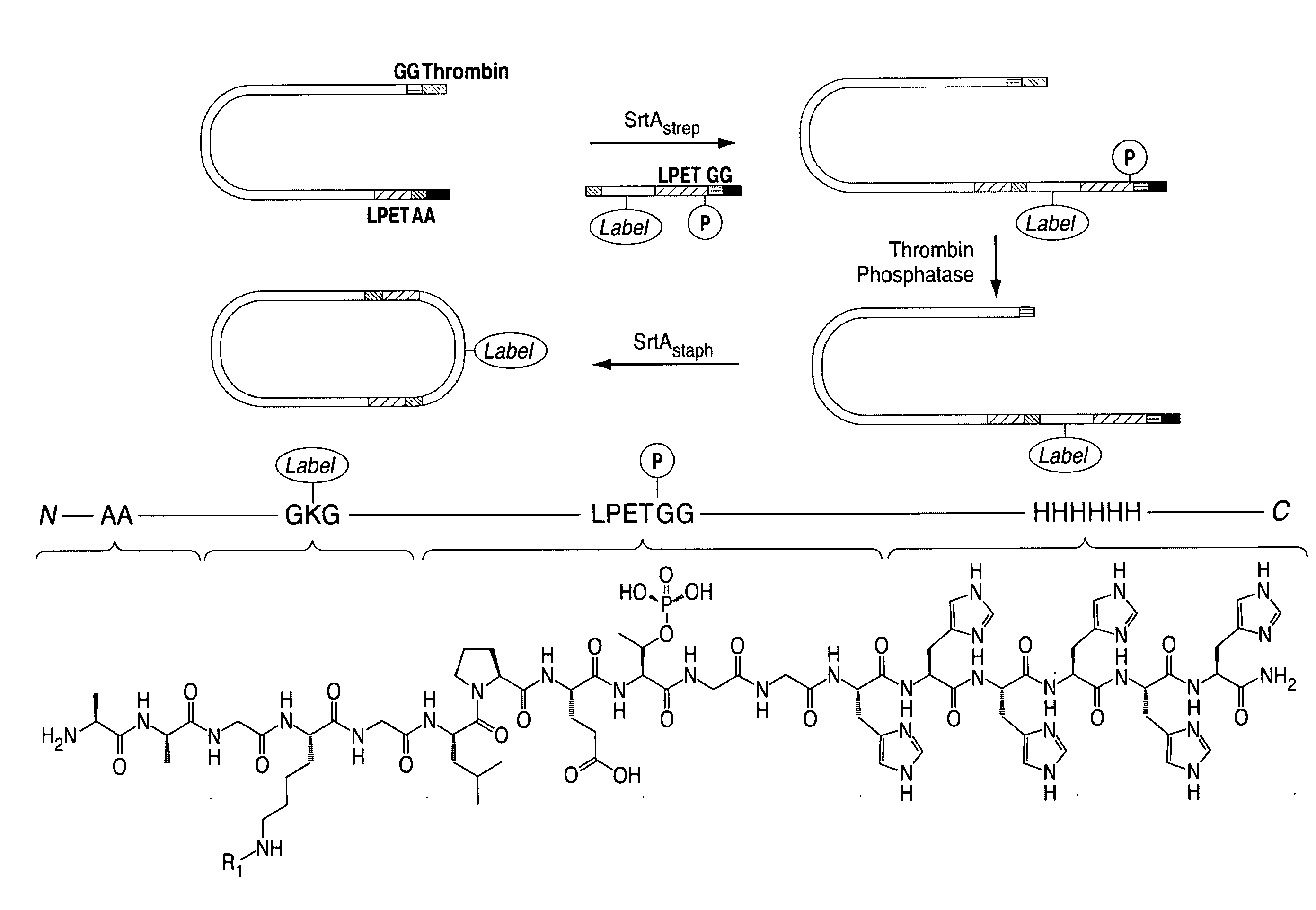Methods for ligation and uses thereof
a technology of ligation and methods, applied in the field of compositions and methods for ligation, can solve problems such as and achieve the effect of facilitating n-terminal ligation and limiting the efficiency of ligation reaction
- Summary
- Abstract
- Description
- Claims
- Application Information
AI Technical Summary
Benefits of technology
Problems solved by technology
Method used
Image
Examples
example 1
DISCUSSION OF EXAMPLE 1
[0417]In summary, we have developed a general strategy using sortase-mediated transpeptidation as a means to install hydrophobic lipid modifications onto protein substrates in site-specific fashion. The ease of use of this method stands out as a significant asset. Protein substrates require, e.g., only a five amino acid extension (such as LPETG) to serve as sortase substrates, a modest insertion that is not expected to impede the function of most proteins and should also have minimal impact on the expression yield of these polypeptides. Recombinant proteins containing the LPETG motif are also stable and unreactive until activated by the sortase enzyme. This affords a distinct advantage over the expressed protein ligation approach where premature cleavage of intein fusion proteins has been documented, leading to a reduction in the yield of final ligation products. The requisite lipid-modified nucleophiles compatible with sortase-mediated transpeptidation also h...
example 2
Modification of N-Terminal Glycine Residues using Structural Mimetics of the Sortase A Recognition Sequence
[0466]The transpeptidation reaction catalyzed by sortase A has emerged as a general method for derivatizing proteins with a variety of modifications. Yet, in its present incarnation, it appears that the practical application of this approach has been limited to the protein C-terminus. Target proteins are engineered to contain the sortase A recognition motif (LPXTG) near their C-termini. When incubated with synthetic peptides containing one or more N-terminal glycine residues and recombinant sortase A, these artificial sortase substrates undergo a transacylation reaction resulting in the exchange of residues C-terminal to the threonine residue with the synthetic oligoglycine peptide. The use of excess oligoglycine drives this equilibrium process, and in most cases quantitative protein labeling can be achieved.
[0467]In simple terms, the transpeptidation reaction results in the li...
example 3
Highly Efficient Sortase-Catalyzed Protein Circularization
[0471]This Example demonstrates that sortase-catalyzed transpeptidation can be used for efficient synthesis of circular and oligomeric proteins. This method has general applicability, as illustrated by successful intramolecular reactions with three structurally unrelated proteins. In addition to circularization of individual protein units, the multiprotein complex AAA-ATPase p97 / VCP / CDC48, with six identical subunits containing the LPXTG motif and an N-terminal glycine, was found to preferentially react in daisy chain fashion to yield linear protein fusions. For supplemental figures, additional methods, and references, please see, Antos, J M, et al. “A straight path to circular proteins” J Biol Chem.; 284(23):16028-36, 2009.
[0472]Synthesis of Triglycine Tetramethylrhodamine Peptide. The structure of GGG-TMR5 and a detailed synthetic protocol are provided in the supplemental material and supplemental Fig. S7.
[0473]Materials an...
PUM
| Property | Measurement | Unit |
|---|---|---|
| temperature | aaaaa | aaaaa |
| pH | aaaaa | aaaaa |
| temperature | aaaaa | aaaaa |
Abstract
Description
Claims
Application Information
 Login to View More
Login to View More - R&D
- Intellectual Property
- Life Sciences
- Materials
- Tech Scout
- Unparalleled Data Quality
- Higher Quality Content
- 60% Fewer Hallucinations
Browse by: Latest US Patents, China's latest patents, Technical Efficacy Thesaurus, Application Domain, Technology Topic, Popular Technical Reports.
© 2025 PatSnap. All rights reserved.Legal|Privacy policy|Modern Slavery Act Transparency Statement|Sitemap|About US| Contact US: help@patsnap.com



